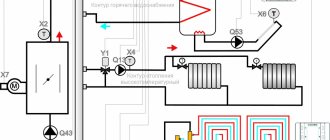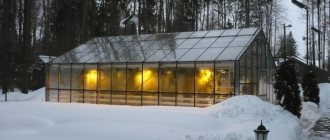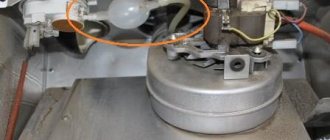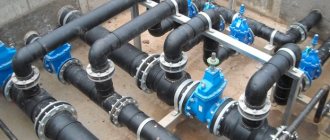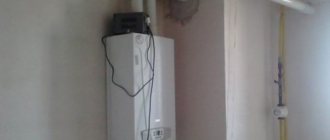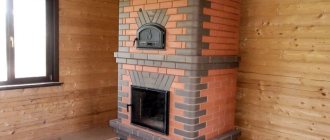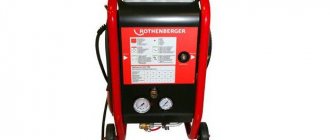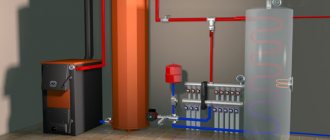Heating systems with natural circulation
The natural circulation heating system became widespread in the pre-war period due to its efficiency, simplicity and reliability. Most often, this type of heating system is used in dachas, as well as in country houses due to frequent power outages at such facilities. Such systems are conventionally divided into two types - with bottom and top water supply. To determine the choice of the type of heating system, it is necessary to consider their differences, characteristics and scope of application.
Schematic diagram of heating with natural coolant circulation
Heating systems with natural circulation
Features of equipment repair
Repairing heating equipment requires a responsible approach.
Gas boiler repair
The gas boiler is the main and most complex element in the entire heating system of a private home. Automation of this equipment is proceeding at such a pace that even specialists do not have time to keep track of all the innovations. Nevertheless, primary diagnostics and elimination of minor faults can actually be done with your own hands.
Photo 2. The process of repairing a gas heating boiler. Work must only be carried out by a qualified specialist.
Most boiler problems that you can fix yourself are described in the equipment data sheet.
Boiler breakdowns that can be repaired independently:
- Malfunctions of the boiler caused by voltage fluctuations in the electrical network. To eliminate this, connect the boiler through a stabilizer or uninterruptible power supply.
- The pressure has dropped, the boiler has stopped and will not turn on. The pressure in the system is raised to normal by opening the water supply tap.
- Boiler shutdown due to overheating. The heat exchanger is clogged on the outside. It will help to completely de-energize the heating device and clean the heat exchanger with a brush and vacuum cleaner.
Important! the cleaning of parts inside the boiler to professionals!
- The AGV turns off after 2-3 minutes of operation and does not turn on until it cools down completely. The chimney is clogged. It is recommended to clean the ventilation duct.
- Water is leaking from the gas water heater. To solve the problem, all pipes and clamps inside the boiler are inspected and the leak is eliminated.
Attention! It is important to remember that faulty gas equipment poses a potential danger. Therefore, the main thing is to contact specialists in a timely manner and eliminate any problems that arise.
Correction of pumping equipment
Home heating systems use circulation pumps. These devices are divided into two types: monoblock and collapsible.
If you use a model consisting of separate blocks, then sometimes it is possible to repair it yourself.
Malfunctions of pumping equipment that can be eliminated independently:
- The pump hums, the impeller does not rotate. It is advisable to disassemble the pump, rotate the rotor and, if possible, clean accessible parts from oxidation. Sometimes the cause of such a problem lies in a foreign object that has gotten inside.
- The pump does not hum, nothing rotates. It is recommended to look for the fuse. If it is not there, then it is time to change the pump.
- The pump makes a lot of noise when turned on. There is a large amount of air in the pipes. To troubleshoot problems, open the water make-up valve and bleed air from the boiler.
- The pump stops a few minutes after starting and does not produce enough pressure. Scale or other obstructions have formed on the pump cover, interfering with normal operation. The solution to the problem is to remove and clean the cover.
Heating systems with top water supply
The coolant - in this case water - is heated and supplied to the upper part of the heating system through a pipeline. The pipe used to supply water must have a larger diameter compared to the pipes that are responsible for supplying water to the radiator. This is necessary to achieve the greatest resistance to heat exchange. Horizontal pipes must be installed with a minimum slope of one centimeter per adjusted meter.
The expansion tank must be installed at the top of the system: it will perform the function of receiving steam and excess heat - this is necessary due to the property of water to expand when heated and turn into steam. The tank must have a drain valve and a cap or valve at the top. After the water is heated, it is distributed through the supply pipe to the vertical risers and into the radiators.
Tip: if you are going to use a heating system with natural circulation of water, remember that radiators must be connected using a diagonal method
After direct heating of the room, the water passes into the boiler through a specialized pipe - the return. Here it is heated again and the cycle of water movement is repeated. The heating boiler is located in the lowest part of the system, under the radiators. Typically, these elements are installed in boiler rooms, for which basements are allocated.
Leaking heating pipe
Corrosion most often occurs at the junction of the pipeline with the radiator
The cause of interruptions in the heating network is often a leak caused by corrosion or poor-quality pipe connections. If the location of the leak is visible, then the heating problem in the apartment can be solved faster. It is bad if the connection is hidden in the thickness of the wall or in the floor. Then you will have to cut off the entire leaking pipeline branch and install a new one.
We recommend: Gas stove for home: heating in a private home, required burner power
How to seal a leak if necessary? To do this, it is recommended to keep in stock simple plumbing devices for clamping pipes of the appropriate diameter. As a last resort, you can make a homemade clamp: wrap a piece of soft rubber around the leak, and then tighten it tightly with wire.
If a leak is found at the junction of the radiator sections, you will have to bandage this area with a strip of fabric, which has previously been soaked with moisture-resistant glue. It is permissible to use a special sealant, “cold welding” and other means.
The proposed methods of dealing with the problem of heating system leakage are only temporary, and subsequently a major repair will be required.
In advance, before the start of the heating season, inspect all pipelines and radiators in the apartment to see if there are any leaks. Owners of an autonomous heating system should test its performance in the fall.
Finally, we can advise: if you have any problems with heating in an apartment or in your private home, contact a specialist. Only they know how to correctly design a system, install a boiler, install pipes and connect radiators.
Do not skimp on the quality of the purchased equipment, so as not to spend money on repeated repairs if the faucet you bought on the cheap suddenly breaks and floods the room.
Learn to correctly identify the causes of heating problems and begin to eliminate them competently. In other words: think twice, fix once!
Heating systems with bottom water supply
A system in which coolant is supplied from below is usually used for heating houses where there is no attic space or access to it is closed. The main difference of the presented heating system is that the pipes are laid under the radiators. There is also an expansion tank, which is installed in the upper level of the system; Usually utility rooms are used for this purpose. If there is no water circulation in the heating system, which should occur naturally, then it is created by force.
Troubleshooting a two-pipe heating system (continued)
The second article in the series of troubleshooting in the heating system
Dmitry Belkin
Author: Dmitry Belkin
Quite a significant amount of time has passed since the first article was written and, on the eve of the 2011-2012 heating season, I decided to continue the cycle, especially since questions on the topic “I installed the heating, but it doesn’t work”
keep coming.
Unfortunately, troubleshooting methods that do not lie on the surface are quite difficult to classify, and I decided to devote several short articles to the issue of heating system malfunctions. In this article I would like to consider the problem of poor coolant circulation and uneven heating of radiators. I myself have never made mistakes similar to those described and, accordingly, here I will have to theorize a little.
Friends! Before troubleshooting your heating, please find the dirt filter and clean it! Perhaps after this there will be nothing left to look for!
So, we have two-pipe heating. Let's consider one branch of this heating system, serving, say, one floor. Here is her diagram. The water flow is shown by arrows.
The radiator located closer to the beginning of the branch, or to the boiler, is hot. This is the leftmost radiator. There may be significantly more radiators than shown in the diagram. For example, in my tiny house there are 3 branches. The longest one is about 25 meters long and has 5 radiators. The problem is that the radiators next to the first are either completely cold or have a temperature significantly lower than that of the first. Moreover, the further to the end of the branch, the colder and colder the radiators are.
Our first radiator is hot (my hand can barely stand it). We feel the next ones and find that all the radiators are hot, but their temperature decreases as we move along the branch. The latter is no longer hot, but slightly warm. We return to the first radiator, but feel its bottom. We feel the bottom of all the radiators along the branch and find that the bottom of the radiators is much colder than their top. Even the first one.
Conclusion
We have water circulation in our heating branch. There is no air in the pipes. However, the circulation is not fast enough. It is so weak that the water has time to cool while it moves from the radiator inlet to its outlet. Thus, the problem is diagnosed. All we have to do is find its cause and destroy it.
Do we have a circulation pump in our system?
If it is not there, then the problem of accelerating circulation is quite difficult to solve. You need to place the boiler lower, you need to increase the diameter of the riser, you need to increase the diameter of the supply and return lines (horizontal lines), you need to change the pipes to ones with a smoother inner surface, you need to reduce the number of angles and make them obtuse, that is, 100 or 110 degrees. at least more than 90.
If there is a circulation pump, then... solving the problem is not at all easier.
First, let's check if the pump is working. In general, doing this is not as easy as it seems. A good circulation pump operates absolutely silently and without vibration. You can only hear it work by putting your ear to it, but it is hot and you can get burned! I do not recommend that you, dear friends, risk your organs! Stock up on a medical stethoscope or just a large-diameter tube (a piece of plastic sewer pipe with a diameter of 50 mm will do). Attach one end to the motor and stick your ear into the other end. If you hear the motor running, that’s good!
By the way, if your engine is noisy, then it may be broken and needs to be replaced so that it does not become painfully cold, but there is a much higher probability that the air is seething in it. Could this be why the circulation is weak? In this case, turn off the engine and bleed the air. Any engine has means for this. You can drain the water from the pump while it is running, but this must be done extremely carefully so as not to break it (the motor). As soon as water with bubbles stops coming out of the motor, the air release procedure must be stopped, that is, all the holes must be tightened and fresh water added to the system, bringing the pressure on the barometer to the desired level.
Important note!
Re-reading my particularly successful articles, and this article is undoubtedly quite successful, I noticed one inaccuracy. It concerns the release of air on a running pump. The fact is that if your pump is particularly powerful and creates noticeable pressure, then the procedure for bleeding air can turn into airing the entire system. The point is that the water pressure is so high that air is sucked into the system, but the water does not pour out. This depends on the design and power of the pump. Possibly from some other factors. In short, if bleeding is a problem in your system, be sure to turn off the circulator before bleeding. Extra caution doesn't hurt!
Is the pump working? Great! Is it possible to increase the circulation speed on it? Amazing! Let's zoom in and see what happens. If all the radiators became uniformly hotter, then we consider that our branch is simply too long and we used too thin pipes. It is possible that the pipes are of poor quality or there are some obstacles to circulation in the form of a large number of corners, dents in the pipes, and so on. Then we promise ourselves to change everything someday and live in peace. Well, maybe we change the circulation pump to a more powerful one. At the same time, we put up with increased electricity costs. What did you think? Is it so easy to live in a big house? You have to pay for everything.
Let's assume that increasing the circulation speed on the motor did nothing.
We think this is a miracle! Something had to change, or the motor was faulty, after all. At least on the first radiator in the branch, the bottom should become almost as hot as the top. Let's assume there was no miracle! On the first radiator, both the top and bottom became hot, but further down the branch the temperature still does not suit us.
I hope you have valves at least at the inlets of all radiators? We close the valve of the first radiator halfway and feel the rest. Have they gotten hotter? If yes, then we draw the following conclusion.
Conclusion
We have obtained such heating in which it is easier for water to pass through the radiator than to go along the entire branch. Why did it happen? Well, for example, because the diameter of the supply line (or return line, which is the same thing) is smaller than the diameter of the pipes to the inlet and outlet of the radiator. But it should be the other way around. The bore diameter of the lines must be larger than the diameter of the radiator outlets. If you use high-quality, for example, copper pipes, then pipes with an internal diameter of no more than 15 mm should be connected to the radiators. This is enough! Verified by yours truly!
After reaching this remarkable conclusion, we believe that we got off lightly and live by regulating the circulation in our branch with valves. This, of course, does not add comfort. We change the valves to automatic thermostatic ones and, I hope, we get quite normal heating that regulates itself. After this we live in peace.
Next option. Both lines are hot and the radiators are cold. In this case, the valves on the radiators are fully open.
By and large, this is also a miracle. In this case, the radiators cannot be completely cold. But if water rushes along the highways at the speed of a racing car, but does not enter the radiators, then this means that the problem is either in the radiators all at once), or in the node connecting the radiator to the highway, and not necessarily the upper, input node, so to speak . If the problem is in the lower, output node, then the effect will be exactly the same. In other words, if we block the radiator outlet, it will be absolutely cold, as if we blocked the input. Why are control valves placed on top? Just so that you don’t have to bend too low to adjust them, and you don’t accidentally hit them with your foot.
If we consider radiator malfunctions, then it is much more likely that the problem will be in only one of them, but not in all of them at once. In this case, you need to deal with one thing. Most likely the problem is in the valve. This is where I think we should start.
And one last thing. If we have an air lock or blockage in the middle of the line, then what do we get? All radiators and the line will be hot before the blockage, and the supply and return lines immediately behind the operating radiator will be cold.
NOTE!
If this happens, this does not mean at all that the problem is somewhere near the working radiator. The problem can be anywhere in the gap between the supply and return lines between the working radiator and the first non-working one. This is very important to understand! Understanding this crucial point can save you a lot of time and effort. And money too.
I’m not too lazy to even draw a diagram
That's all. I hope this article was useful to someone. As always, I will be glad to receive comments and “cases from life.”
Dmitry Belkin
Article created 10/19/2011
Heating systems with forced circulation
A standard forced circulation heating system operates using the same connection methods. The difference is that due to the large extent of this system or the lack of natural conditions to create an inclination of the pipes, it is necessary to include a pump in the system. The circulation pump is mounted to the main pipe - this helps to increase the service life of the heating system. Using a pump helps not only increase heating efficiency, but also reduce the number of lines. A forced circulation system has the ability to heat not just several rooms, but even a house with several floors.
Heating systems with forced circulation
In order to produce high-quality operation of this type of system, a continuous power supply is required. Installation of a circulation pump in the heating system is required in order to create forced circulation of water in a closed loop. In this type of system, the pump is the central component among the equipment. It should be noted that the circulation pump may not have significant performance: its power is only needed to direct the liquid into the supply pipe. The same pressure pushes the water in the opposite direction, since the system is closed.
The circulation pump is necessary to ensure uninterrupted operation of the heating system, therefore it must fully comply with the system into which it is installed. Due to its functionality, this type of pump can be widely used in a wide variety of pipelines.
Coolant circulation in a combined (branched) heating system
Let's start analyzing the coolant circulation with a complex system - then you will understand simple circuits without problems.
Here is a diagram of such a heating system:
It has three circuits:
1) boiler - radiators - boiler;
2) boiler - collector - water heated floor - boiler;
3) boiler - indirect heating boiler - boiler.
Firstly, it is necessary to have circulation pumps (H) for each circuit. But this is not enough.
For the system to work as we want: the boiler is separate, the radiators are separate, we need check valves (K):
Without check valves, let’s say we turned on the boiler, but the radiators “out of the blue” began to heat up (and it’s summer, we just needed hot water in the water supply). Cause? The coolant went not only to the boiler circuit, which we now need, but also to the radiator circuits. And all because we saved on check valves, which would not allow coolant to pass where it was not needed, but would allow each circuit to operate independently of the others.
Even if we have a system without boilers and not a combined one (radiators + water heated floor), but “only” branched with several pumps, then we install check valves on each branch, the price of which is definitely less than reworking the system.
Selecting a circulation pump for a heating system
In order to select a circulation pump for the heating system, it is necessary to make the appropriate calculations. Please note that within an hour, this element will drive three times more water than its total volume in the system. Thus, the total volume of a suitable amount of liquid is on average 10 liters per 1 kilowatt of heating boiler power. The required pump model for the heating system and its power are determined by pressure and flow parameters. The pressure must be equal to the hydraulic resistance of the heating system.
Circulation pump
Typically, the fluid pressure velocity in systems with forced circulation is quite low, which gives the right to judge low losses of hydraulic resistance, which usually do not exceed 2 meters. It is quite difficult to calculate the exact resistance, so the performance of the circulation pump is determined by the midpoint. In order to calculate productivity, the size of the area of the heating object and the power of the electricity source are also taken into account. It should be remembered that a pump is only needed in a system with forced circulation; a system with natural circulation does not need it.
What does pressure in the house affect?
The first and most important thing is the efficiency of heat transfer from the producer (boiler room) to the consumer (radiator in the apartment). There are prescribed standards and SNiPs that regulate the supply of pressure to apartment buildings. Its value is calculated based on the type of pipeline used, the cross-sectional diameter of the pipes, the types of device connections, and the distance from the location of the boiler room. Due to incorrect pressure supply, the circulation of the coolant can completely stop, which immediately leads to freezing of pipelines in winter and can permanently disable the heating.
There are several types of pressure: dynamic and static. Dynamic occurs in pipes when the coolant moves; it affects radiators, pipes, shut-off valves. Static occurs due to gravity. This can be observed in gravity heating systems of private houses, when circulation pumps were not yet used, and radiators were made in the form of registers made of metal pipes. Thus, the boiler, as a result of heating the liquid and its expansion, pushed the coolant, which further spread due to gravity.
Installing a circulation pump: what should you pay attention to?
To install the circulation pump yourself, use the following recommendations:
- To extend the service life of the entire system, install a filter to clean the liquid in front of the circulation pump. the filter must be installed on the suction pipe;
- do not choose a circulation pump for the heating system with greater power and performance than required. Otherwise, there is a risk of encountering additional unpleasant noise during its operation;
- Never turn on the pump before filling the heating line with water and removing air from it, this can lead to equipment failure;
- install the pump in an area as close as possible to the expansion tank;
- When installing the pump in a closed heating system, if possible, install the pump on the return line. This is due to the fact that this section of the highway has the lowest temperature.
Installing a circulation pump
Advice: before starting the heating system, it is necessary to rinse it with water to remove various foreign particles. Do not forget that even short-term idle operation of the circulation pump in the absence of liquid in the system can result in failure of the pump itself and other elements of the system.
Almost all circulation pumps on the market today are equipped with a connection to the automatic control of heating boilers. This function provides owners with the opportunity to regulate the air temperature in a heated facility by changing the speed of water movement in the heating system. In order to take into account the level of heat consumption in the premises, special meters are installed, thanks to which heat losses arising due to wear and tear of the lines are controlled. The heating circuit itself is not subject to any changes.
You can learn how to install the circulation pump yourself by watching the video:
Repair of boilers for home heating systems
Scheme of water heating of a private house.
Repairing heating boilers with your own hands requires special knowledge, experience and skills. In addition, it will not be possible to do without specialized tools and equipment. The need for such events can be caused by various reasons. So, in some cases we are talking about minor breakdowns or simple preventive maintenance, in others, the repair of home heating boilers is associated with eliminating the consequences of various accidents.
A lot in this case depends on the homeowner. If he does not neglect preventive measures and carries out regular inspection and maintenance of the equipment, both with his own hands and with the involvement of qualified specialists, then serious repairs are unlikely to be required. It's another matter if the system works without proper attention and care. Over time, such disregard of its interests on the part of the owner will result in the appearance of many problems, so it is imperative to show due care and attention to the heating system of your home. In this case, you will almost certainly be able to limit yourself to minor preventive repairs that you can do yourself.
Heating system maintenance includes:
Scheme of operation of a steam heating system.
- correct boiler settings;
- preparing equipment for the heating season;
- checking sensors;
- checking the operation of equipment automation;
- identifying the causes of boiler failure.
We recommend: How to blow out a radiator: the five most effective ways
Of course, if, for one reason or another, you need to carry out more serious repairs of heating boilers, you will have to involve specialists with qualifications and experience, because by doing the repairs yourself without the proper knowledge, you can make everything even worse.
It is very important to understand that there is a huge variety of different equipment on the modern market. Consequently, when it comes to repairing heating boilers with the replacement of parts and components, additional difficulties may arise in finding them. That is why experts advise performing all preventive work in a timely manner. Then it will be possible to order the necessary components in advance, without waiting until they completely break down.
How to choose a circulation pump model
When choosing pumping equipment, pay attention to the simplicity and reliability of its operation, as well as energy consumption. In addition to these important qualities, pump power and pressure are important.
These characteristics are determined by the size of the heated room. You can refer to the following examples:
- for houses with an area of 250 sq. meters, purchase pumps with a pressure of 0.4 atmospheres and a capacity of 3.5 cubic meters. meters per hour;
- for houses whose area is in the range of 250-350 square meters. meters, purchase pumps with a pressure of 0.6 atmospheres and a capacity of 4.5 cubic meters. m/h;
- for houses with an area exceeding 350 square meters. meters, reaching up to 800 sq. meters, purchase pumps with a pressure of 0.8 atm. And with a capacity of 11 cubic meters. m/h.
For a more accurate selection of a circulation pump for a specific facility, calculations are carried out by specialists, taking into account the length of the entire system, the number of installed radiators and their type, the shut-off valves used, the diameter of the pipes, as well as the material of their manufacture, and the type of fuel. For more details, see the article “Selection and nuances of installing a circulation pump for heating.”
Mounting the circulation pump on the bypass (jumper) allows you to easily remove the equipment for replacement or routine repair and maintenance
Air pockets that form in each radiator and in places where the pipeline rises vertically can interfere with the normal circulation of the coolant in the heating system. You can combat air accumulations by installing Mayevsky taps on each radiator or special automatic air vents. Installation of these devices will prevent “airing” of individual sections of the system and disruptions in heating operation that affect the microclimate in the room.
Causes of deterioration in blood pressure
- Illegal spontaneous work on replacing pipelines - in apartment buildings the so-called “top heating supply” is often used, which means the supply of coolant through the main pipeline to the very top floor and its further distribution along vertical heating risers. If one of your neighbors below or above, as a result of inept and, in fact, criminal actions, narrowed the diameter of the pipeline, from 25 mm to 16 mm, then the entire entrance suffers from a sharp drop in the volume of coolant, which cannot circulate as it should it was before.
- An accident, malfunction or outdated equipment of heating networks - unfortunately, this remains one of the most widespread reasons for the poor quality of heat supply to apartments. Heat loss also depends on how high the pressure is in the heating system of an apartment building and how stable it is. Stable high pressure and good circulation allow the coolant temperature to be supplied almost the same as that obtained at the outlet of the heating manifold. If there is a broken valve, a destroyed pipe, or faulty fittings in the path of hot water, this will immediately lead to a deterioration in the heat supply in the apartments.
- Apartment buildings use a closed heating system. It is much more efficient than gravity and does not require large maintenance costs, but a drop in pressure in the system instantly stops the circulation of the coolant. This forces water to be pumped up in case of leaks, and to control the formation of air pockets, which are released using air vents or special valves at the top point of the heating system. If, as a result of an accident, improper operation of equipment, or due to interference with the heating system, a large amount of air is formed in the pipes, circulation decreases or stops altogether.
One of the main heating problems is leaking radiators. There are several components worth highlighting here:
- Steel radiators and convectors are most often not intended for installation in a working environment of more than 8-10 atm. Check with the seller or look in the passport for the parameters of the maximum permissible pressure and operating conditions in which the manufacturer recommends installing its heating devices. Even if your pressure gauge in the basement of your apartment building shows a pressure of 5 Atm., this does not mean that during the season the pressure will not rise to 12-13 Atm. Unfortunately, the wear of main pipelines can reach more than 100%, and the only way to check the integrity of the pipes and ensure trouble-free operation of the heating system is to carry out pressure tests. In these cases, the heating plant can supply a peak pressure of both 13 and 15 Atm, which will lead to the destruction of steel batteries. Measurements are taken every hour, and the pressure drop should not exceed 0.06 Atm. All this time, your radiators will be under dangerously high pressure.
- Long service life of batteries can lead to the formation of corrosion, and if in a private house, at a pressure of 1.5-3 Atm. the radiator can be quickly shut off, then in an apartment building, as a result of such an accident, you can flood your neighbors while you wait for the plumber or emergency crew to arrive. In this regard, in apartment buildings it is mandatory to install shut-off valves, shut-off valves or taps.
If you want to control pressure parameters, you can install special thermomanometers that allow you to evaluate operating heating parameters in real time.
In cases of a drop in temperature, pressure, leaks or damage to the heating system, you must immediately contact the operator servicing your heating network. Otherwise, you risk making the situation worse, which will lead to more serious consequences than a drop in battery temperature of a few degrees.
The simplest climate network of a private house consists of a heating boiler, heating radiators and pipes connecting these elements into a closed ring through which the coolant circulates. However, the heating systems of multi-storey buildings are designed completely differently, which must be taken into account when repairing or modernizing its component located in the apartment. Otherwise, problems with neighbors and the housing office cannot be avoided.
Lower and upper wiring diagram of autonomous circulation
Based on the type of wiring, heating circuits are divided into structures with lower and upper wiring. With lower wiring, the supply line is laid at the bottom of the coolant flow diagram, like the return pipe. Both lines are located below the heating devices. This design has high hydraulic stability and is convenient in that it allows the vertical pipes of the risers to be moved outside the rooms. With this arrangement, all circuit regulators (valves, locking mechanisms) are located in one room, usually a basement or technical floor.
Bottom distribution of heating pipes saves heat, because they are not installed in attics or ceiling spaces. The disadvantage of this type of heating is the need to install air bleed valves on each radiator, as well as constant air locks.
With the upper type of wiring, the pipeline with the coolant passes in the upper part of the heating circuit. Typically it is located in the attic or in the space between the ceiling and roof. Return pipes are installed below heating radiators. An expansion tank is placed at the highest point of the circuit. It regulates the pressure inside the structure and eliminates the occurrence of air congestion. This type of heating cannot be installed in a house where there is no roof slope. The disadvantage of the upper distribution is the negative gravitational pressure in the vertical pipes. This interferes with the flow of water and reduces hydraulic stability. With overhead wiring, it is impossible to drain the risers centrally.
In addition to the lower and upper wiring, there is also a mixed one: the supply line runs from above, and the return pipeline passes through the lower part of the heating structure. This approach is reasonable if a multi-storey building has its own autonomous boiler located under the roof.
